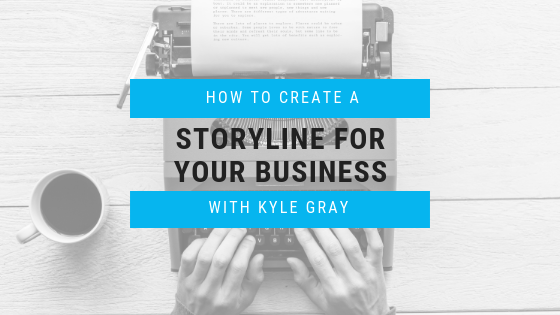Kyle Gray is the founder of Story Engine, where he helps entrepreneurs create powerful storylines for their businesses with the goal to drive sales, growth, and engagement.
He does this by helping his clients find the most interesting aspects of their stories and guiding them through the storytelling process.
On the podcast, Kyle discusses how to find your story and sell it in a compelling way.
Why Should Your Business Incorporate Storytelling?
For as long as there’s been a common language, there have been stories. They’re integral to the human condition.
Because of progression in technology, Kyle believes that stories are more important today than ever before, what with social media and the device in our pocket that can contact anyone in the world at a moment’s notice.
While the internet is filled with charismatic storytellers, most are missing a vital component: trust, which is also known as the human connection.
With all of the scams and trickery that pervade the internet, people have become a bit cynical, Kyle believes.
With a great, authentic story, you can melt the ice grown around the average internet user’s heart. A story can allow you to put yourself out there and tell people what you care about—what you do, who you serve and who you work with.
Unlike a boring sales pitch, this allows the customer to get to know you on a personal level. They won’t feel sold to, but opened up to.
How Did Kyle Discover the Power of Stories?
Before going into marketing, Kyle wanted to be a musician. He spent hours upon hours crafting stories with songs and melodies.
This same creativity later resurfaced when Kyle entered the marketing field, so he harnessed it for those purposes. He has taken that same impulse to tell a personal story through music and rechanneled it into marketing.
“It’s an emotional experience and it gives people something that they can step into and engage with and enjoy and relate to,” Kyle says.
What Do You Need to Know Before Telling Your Story?
When working with clients, Kyle uses one of the classic storytelling techniques, the “hero’s journey,” which is a tried-and-true, 12-step process for telling a good story.
Of course, Kyle adapts this storytelling technique to marketing, turning it into something more akin to the “buyer’s journey.” This is because you have to understand the inner mindset of the consumer, especially how they go from being ignorant of your product to buying your product.
Before starting on your own story, you want to make sure your story is for your audience—it shouldn’t be for you or for one specific person, but for the demographic of consumers your product is designed for.
There are three basic elements when it comes to telling your story.
The first one is letting people know you exist, which is going to be slightly different depending on your target audience.
Then, there’s putting on a human face and getting the consumer to engage with you as a person, not as a business.
Lastly, there’s the trust aspect. They need to trust that you can deliver results.
What Are the Broad Outlines of Your Story?
The first step of the hero’s journey is establishing the status quo—a sense of normalcy.
At this point, you should be asking yourself, who is the hero (your target demo) and what is the problem (the target demo’s desires)?
After this comes the call to adventure.
You need to give the hero something that will force them to leave their comfort zone and seek a solution (your product).
Next, the hero meets the guide, which is you.
From the guide, the hero learns about his or her problem—think of Gandalf or Hagrid.
Once the hero knows about the problem, you can give them solutions (your product) and prepare them for the journey (investing money).
How Do You Actually Craft a Story?
Within this larger narrative context, you can also weave smaller, simpler stories.
For instance, if someone wants to buy but is hesitant, you can tell them a story of when you hesitative before making a decision and lost.
These stories should, if possible, come from a personal place. Try to connect with the consumer in a way that forms an emotional bond between both of you.
This bond will immediately set you apart from other companies, who are using cold marketing language.
There’s also a technique Kyle uses called “embedding.” This involves encapsulating your product and services through the Trojan Horse of a story.
For instance, a normal sales pitch might be, “we can create more email automation that can increase buying.” With embedding, you would be telling the consumer about a time you helped someone (much like them) with their product by adding more email automation that increased buying.
It’s a clever framing device that can do wonders.
Video is another powerful tool in the storyteller’s arsenal, because it allows for an even more personal connection than with writing. Being able to see your eyes creates a level of intimacy that can’t be found in the written word.
Where Can You Learn More About Kyle Gray?
If you like Kyle’s ideas about storytelling and would like to know more, you can buy his book, “The Story Engine.” He also has another book coming out soon, called “Selling with Story.”
You can also read his blog at TheStoryEngine.co, which goes deeper into his fusion of storytelling and marketing. There’s also a quiz that helps you find your story, in case you’re still having trouble.
Kyle has recently started a podcast that covers a lot of the same topics.














